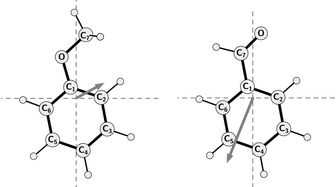The rotational spectra, electric dipole moments and molecular structures of anisole and benzaldehyde†
Abstract
The

* Corresponding authors
a
Institute of Physics, Polish Academy of Sciences, Al. Lotników 32/46, 02-668 Warszawa, Poland
E-mail:
kisiel@ifpan.edu.pl
Fax: 048-22-8430926
b Harvard-Smithsonian Center for Astrophysics, 60 Garden Street, Cambridge, USA
c Division of Engineering and Applied Sciences, Harvard University, 29 Oxford Street, Cambridge, USA
d Department of Chemistry, University of Warsaw, Pasteura 1, 02-093 Warszawa, Poland
The

 Please wait while we load your content...
Something went wrong. Try again?
Please wait while we load your content...
Something went wrong. Try again?
O. Desyatnyk, L. Pszczółkowski, S. Thorwirth, T. M. Krygowski and Z. Kisiel, Phys. Chem. Chem. Phys., 2005, 7, 1708 DOI: 10.1039/B501041A
To request permission to reproduce material from this article, please go to the Copyright Clearance Center request page.
If you are an author contributing to an RSC publication, you do not need to request permission provided correct acknowledgement is given.
If you are the author of this article, you do not need to request permission to reproduce figures and diagrams provided correct acknowledgement is given. If you want to reproduce the whole article in a third-party publication (excluding your thesis/dissertation for which permission is not required) please go to the Copyright Clearance Center request page.
Read more about how to correctly acknowledge RSC content.
 Fetching data from CrossRef.
Fetching data from CrossRef.
This may take some time to load.
Loading related content
